THE DECISIVE MOMENT
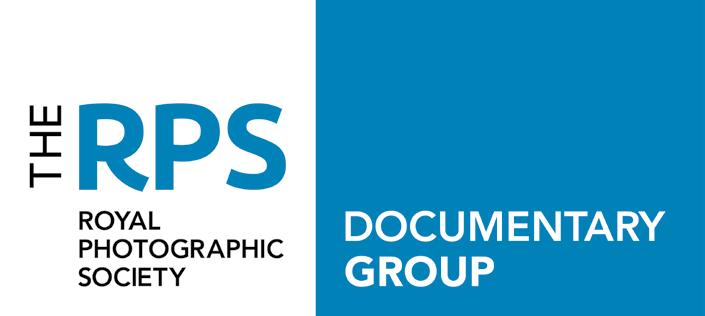







Sub Group Organisers:
Northern: Gordon Bates LRPS docne@rps.org
Southern: Mo Connelly LRPS doc@rps.org
Chairman : Mo Connelly LRPS
Retired from the UN refugee agency after a career as a workaholic, frequently living in a tent on remote borders in troubled regions. Have now achieved my work-life balance by getting a life after work. What do I like? Photography, photographers, being at home, travelling and people who respect human rights. What do I dislike? The fact that I am becoming a grumpy old woman and actually enjoying it.
Treasurer : Justin Cliffe LRPS
I have been interested in photography since my late teens however family and work commitments took then priority and I’ve really only got back to it over the past 5 years since retiring from a life in the City. I joined the RPS, and the Documentary group, about 4 years ago and was awarded my LRPS in 2013. I am also a member of Woking Photographic Society and the Street Photography London collective. My particular interest is ‘street photography’, something that I’m able to combine with my part time work for a charity in London.
Secretary: David Barnes LRPS
I have been interested in photography since childhood and have been actively taking and making images for many years with a few lapses caused by work and the onset of family responsibilities. I retired in 2005 after a career in the IT industry. I have since combined sport spectating with photography – I spend most Saturday afternoons in winter kneeling in the mud, camera in hand, at my local rugby club. I feel at home in towns and cities and spend time in London where there is always something happening that seems to me to be worth recording.
South East: Janey Devine FRPS docse@rps.org
Thames Valley: Philip Joyce philip_joyce@btinternet.com

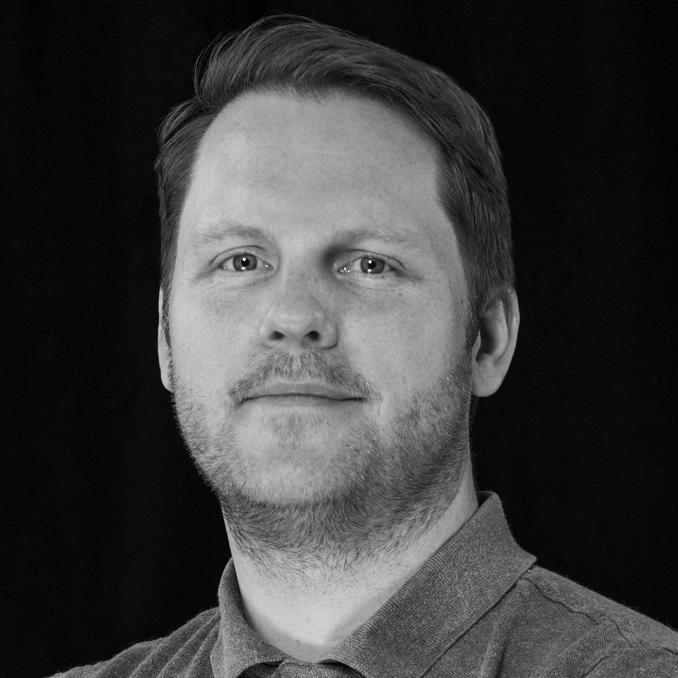

DM Editorial team:
Sub Editor: Belinda Bamford
Sub Editor: Dr Graham Wilson
Committee Member and Coordinator for DG Sub-Groups:
Bates LRPS
I joined the RPS in 2013 and was awarded my LRPS in 2014. My main interest is in documentary and street photography and I have been a member of the Documentary Group since joining the Society. I was instrumental in forming a Documentary Group in the Northern Region in 2015. My other involvement with photography is as a trustee and board member of the arts organisation, Multistory, in the West Midlands.
Committee Member and Decisive Moment Editor:
Photography has been part of my life ever since I was at art college. After a trip to Nepal in 2006 my passion was ignited and I’ve been developing my photographic abilities ever since. Having experimented in a variety of photographic genres I now focus on longer term documentary projects. I’ve worked closely with commercial photography throughout my career in advertising but enjoy all forms of documentary and travel for my personal work. I joined the DG to be part of a like minded community of peers and by happy chance have ended up editing our groups digital magazine.
Committee Member and Group Webmaster: Steven Powell
I have enjoyed a turbulent relationship with photography over most of my adult life with my technical ability often letting down my vision! Nevertheless I’m always ready for that one-ina-million shot which makes every thing worthwhile. I joined the Documentary Group in 2016 to see more examples of the style I love so much. As well as looking after our website and bimonthly competition, I’m occasionally called on to document interesting events at work to help promote the efforts of other teams. I’m aiming to achieve the LRPS accreditation (and catch up with the rest of the team).
DPoTY 2017 team:
Organiser: Mo Connelly LRPS
PR: Dee Robinson ARPS
Entry Manager: Chris Barbara ARPS
Technical: Jhy Turley ARPS
And the rest of the team:
Bi-monthly competition manager: Steven Powell
Social Media: Steven Powell
Flickr: Chris Barbara ARPS
8 Documentary Photographer of the Year 2017 10 David Fletcher - Losing a calf
14 Lynda Morris LRPS - Appleby Horse Fair 2017
18 Stephen Reynolds - The Sonepur Mela
22 Suzy Luard - Mourning the Closure of the White Horse Strip Pub in Shoreditch
26 Chris Upton ARPS - Thoresby, the end of the mine
30 Ann Chown ARPS - Today’s Fishermen of the Stade, Hastings
34 Interview with Polly Braden
48 Winner of the 5th Bi Monthly Competition Member Images
50 Bob Train LRPS - Contrasting Sports Camps
56 Brian Vickers LRPS - M6 Service Stations
60 Gianluca Calise - The Waiting
72 James Valls-Enriquez - Mud Wrestlers of Akhada, India
78 Paul Reyonlds ARPS - St Georges Hub Wolverhampton
86 Penny Dixie ARPS - Hedgehog Heroes of Regent’s Park
92 World Press Photo Exhibition 2017 Review
Exhibition
RPS Documentary Photographer of the Year 2017
On until 20th January 2018
Horsham Museum
For more detials click HERE
Workshop
Documentary Photo Essays - FULL
With Alison Baskerville (www.alisonbaskerville.co.uk)
13th January 2018
Salisbury
For more detials click HERE
Sub Group Meeting
Northern Documentary Group Meeting
18th January 2018 – 10:30 - 16:00
Kibblesworth Village Millennium Centre
For more detials click HERE
Sub Group Meeting
South East Documentary Group Meeting
21st January 2018 – 10:0 - 13:00
Tangmere Village Hall
For more detials click HERE
Workshop
Documentary Photo Essays
With Alison Baskerville (www.alisonbaskerville.co.uk)
17th February 2018
Norwich
For more detials click HERE
Sub Group Meeting
South East Documentary Group Meeting
25th March 2018 – 10:0 - 13:00
Tangmere Village Hall
For more detials click HERE

The highlight of the last three months in 2017 has been the selection of the winners for the RPS DPoTY, the awards and opening of our exhibition at the Printspace, and the same exhibition, which is now showing at the Horsham Museum until late January. I’d like to express the Committee’s big thanks to our judges, Ali Baskerville, ARPS, Steve Kingswell, ARPS and Ken Lennox, Hon FRPS, and also to the Printspace for their great support, organising and hosting the DPoTY exhibition.
Much of this quarter’s journal is dedicated to the RPS DPoTY 2017. We decided to open up entries in 2017 to all RPS members. It was a great deal of work for a small group of volunteers. Disappointingly, only one in four entrants was a member of the Documentary Group (less than seven percent of our membership).
At a recent Committee meeting, we agreed we had the experience to run this more easily in the future, having learned many lessons. We also agreed that we needed to know more about what our documentary members want, before embarking on a lot more work. It was decided that we will not run the DPoTY in 2018, and will survey our Documentary members to seek their views on what is wanted from the Group. Please take the time to complete the survey as your input is very important, as the results will be used to plan our next programme.
At the same Committee meeting, we agreed that our focus in 2018 would be to encourage more Documentary Sub-Groups and to focus on workshops and other activities in those areas where we have established sub-groups.
We will be holding a one-day meeting with our sub-group coordinators and volunteers in April. This, together with the survey, will help us to plan the strategy and activities for 2018 /19.
Decisive Moment will continue to be our flagship activity together with the bi-monthly competition, and we feel the need to encourage and foster more local meetings and activities.
I thought my advert for a new Chair from next April was rather good, however, it couldn’t have been as not one person expressed an interest! Could I encourage anyone who might be interested in the opportunity, to put his or her name forward? You don’t have to be a great photographer (after all I’ve done it for five years!), but rather to be really interested in photography, and enjoy working with and meeting others.
So now I’ve had my small rant let me assure you that I love being Chair of the Documentary Group, but after five years, it is time for a new pair of eyes and ears to look at what we do and how we do it.
It’s hard to believe that it’s already 2018. I hope you’ve all had a wonderful festive break and are looking forward to a New Year of photography.
Best wishes
Mo Connelly,
Chair, RPS Documentary Group
DPoTY is proudly supported by theprintspace.
Their online platform: thehub allows artists and photographers to easily promote & sell fine art limited edition prints of their work and order awardwinning prints, mounts and frames for exhibitions. www.rpsdpoty.com

This year has been our most successful DPoTY to date. There are several reasons for this. Firstly, we opened the competition to the entire RPS. This was an important decision for the Documentary group as it allowed us to not only see the amazing work of RPS members outside the group, but also helped to promote the value of being apart of our group. The second key reason was the support from theprintspace, London. They provided the system for submission, printed all the winners work and contributed a huge amount of their time for free. The use of their exhibition space for 3 weeks elevated the prestige of the launch and gave our winners a powerful platform to showcase their work. Of course, we could not have chosen such worthy winners without the help of our judges. Each who gave up their time to discuss and debate the 120 entries we received. No small task that’s for sure. And
finally, the volunteer team who worked behind the scenes for months to organise and manage the competition. For most of us, it was the first time we had been involved with or managed such an event. We’ve learnt a lot along the way, and although somethings could have worked a little better. We’re all very proud of the success of the 2017 competition.
The 120 entries covered a huge range of subject matter from across the RPS membership. It is inspiring to see how people interpreted the brief of a ‘documentary photo essay’. What determines ‘documentary’ is a constant debate for our membership and it was clear to see why when looking through the submissions!
I think one of the most powerful reasons the standard was so high this year was best described by Alison Baskerville, one of our judges and
presenter at the awards night, she said “It’s difficult to make a decision about what is a great photo story. But what I liked is that you focused on stories that were local to you and on your doorstep”. We are all inspired by globally recognised photographers working in remote, exotic locations on dramatic subjects and events, we sometimes forget there are powerful stories in our communities or interesting subjects just round the corner.
Congratulations to our 6 winners, all of which truly deserve their awards and RPS medals.
All I have left to say is a huge thank you to everyone that entered, and everyone involved in the competition and I hope you enjoy the winners work as much as I do.
Jhy Turley ARPS Decisive Moment Editor.
My main interest is Documentary Photography, in which I would include Photojournalism, Street Photography and Travel. Jeff Walls “neardocumentary” work is an inspiration, as well as Gregory Crewdson.
I try to have a few projects on the go at the same time so wherever I find myself I can add something to one of them. I always try to keep an eye out for interesting subjects, even if they do not fit into an existing project.
I think that any photographer values the approbation of their peers. A vote of confidence from such distinguished judges encourages me to pursue new projects and to continue to develop my personal voice.
My panel is drawn from a long-term project about the New Forest Commoners.
Ann is a New Forest commoner and the 13th generation of her family to have farmed there, and probably the last. The commoners’ rights over the use of common land date back to the 11th Century and include the right to graze animals and to gather wood.
Scaled back over the years, the economy of her farm now depends largely on buying calves to fatten for sale. Margins are tight. Last year Ann bought eight calves in December, and after Christmas they began to fall ill and the first one died in January. Despite their efforts, and the expense of the vet, only two calves survived the winter.
Ann carries on, sustained by her hereditary stoicism and an indomitable sense of humour.






I dabble in a lot of different types of photography, but my most successful photos are those of people and capturing an interesting moment. These have mostly been one off photos and not part of a panel. I’m thinking of trying again to get an ARPS panel together, which has prompted me to think in themes.
Documentary photography really interests me because it depicts life around us and can also highlight and bring social issues to public attention. I really like the work of Martin Parr.
I do a small amount of planning. In the case of Appleby I went specifically for the weekend. If I am going away anywhere I research photos taken in the area beforehand and that works for landscapes. For ‘people’ photos I tend to go to busy places and look up specific events or go to places where there is a good backdrop where I can isolate one or two people. Seaside locations are excellent because there are long promenades and lots of concrete and sand.
I have seen a number of photos from Appleby on Flickr and other social media. I thought it would be a great place to get a series of photos that hung together and I particularly like photographing people in their environment. The people at Appleby were, on the whole, unexpectedly eager to have their photos taken. I think they are proud of their lifestyle and their animals. I took the email addresses of the people that I photographed and sent them copies.
My panel gives a flavour of life at the Appleby Horse Fair. It is an enormous meeting place for people and families who love horses, caravans and dogs. Besides showing the main purpose of the fair, which was bringing horses for sale, my photos give glimpses behind the scenes at some of the characters that were there. The alternate sunny and stormy weather was perfect for photography.
After becoming a DPOTY winner, I think I will try to develop better panels, which really tell a story. I think you have to go and seek these stories and I haven’t come up with any great ideas yet!






I am somewhere in between a Travel and Documentary Photographer, and I would like to do some projects in the UK when I retire next year.
All my work focuses on people who I find make any image interesting. I entered the Sonepur images as they cover religion and beliefs, which I find great to document.
The town of Sonepur is 16 miles north of Patna in the Indian state of Bihar. Every year it has an annual mela (fair), which lasts for one month. It begins on a full moon, which usually falls in October or November. The mela is held at the confluence of two rivers, the Ganges and Gandak and attracts massive crowds of pilgrims, sadhus and local families as well as livestock traders from across India.
The sideshows and entertainment fairs offer a wealth of photographic opportunities. I visited Sonepur in November 2015 and wanted to capture something of the festival activities centered on the riverbanks. Over several days, thousands of pilgrims made offerings and took a ritual bath in the river. The Holy men and their followers also set up camps where they would pray and chant or meditate during this time of spiritual fervour.
As a psychologist, I have a professional interest in people, which is often mirrored in my photography, which includes portraits, travel, and other themes. I would also like to do more photojournalistic work.



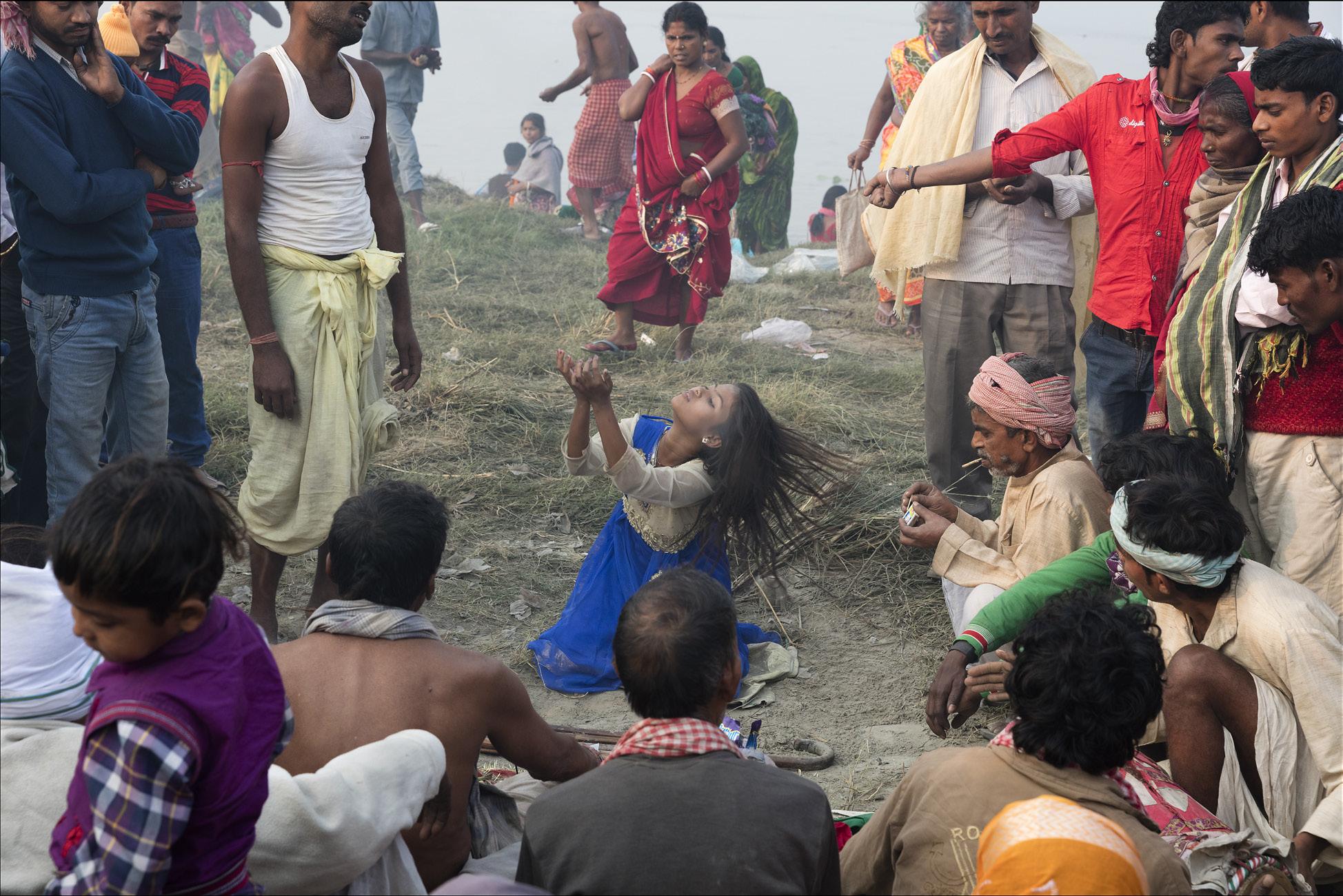


Documentary is part of a larger interest in photography. Becoming a DPOTY winner has certainly increased the exposure of my own work and I feel very fortunate and grateful to have been given the chance to enter this competition. It makes me want to learn more about Documentary Photography and hopefully, the chance to learn from the masters!
I read the local papers in print and online, event websites, and notices and flyers as I walk around London daily and put dates and times in my diary. This local happening evoked emotion in me and I love to spend a lot of time in Shoreditch.
When a family-run strip pub closed because of rising rents the strippers lost their place of work.
The East London Strippers Collective protested with ‘RIP Shoreditch’, a New Orleans style funeral procession held on 14th August. Commencing at the White Horse pub along Rivington Street, ending at the Red Gallery with an exhibition and party. The atmosphere was electric with the beautiful ladies in their stripper costumes carrying a life-size coffin, accompanied by fabulous jazz music provided by a saxophonist and a drummer. I was so caught up with emotion and sympathy for the strippers that after photographing the procession, I joined the procession with flowers in my hand. Has Shoreditch just lost more of its wildness?

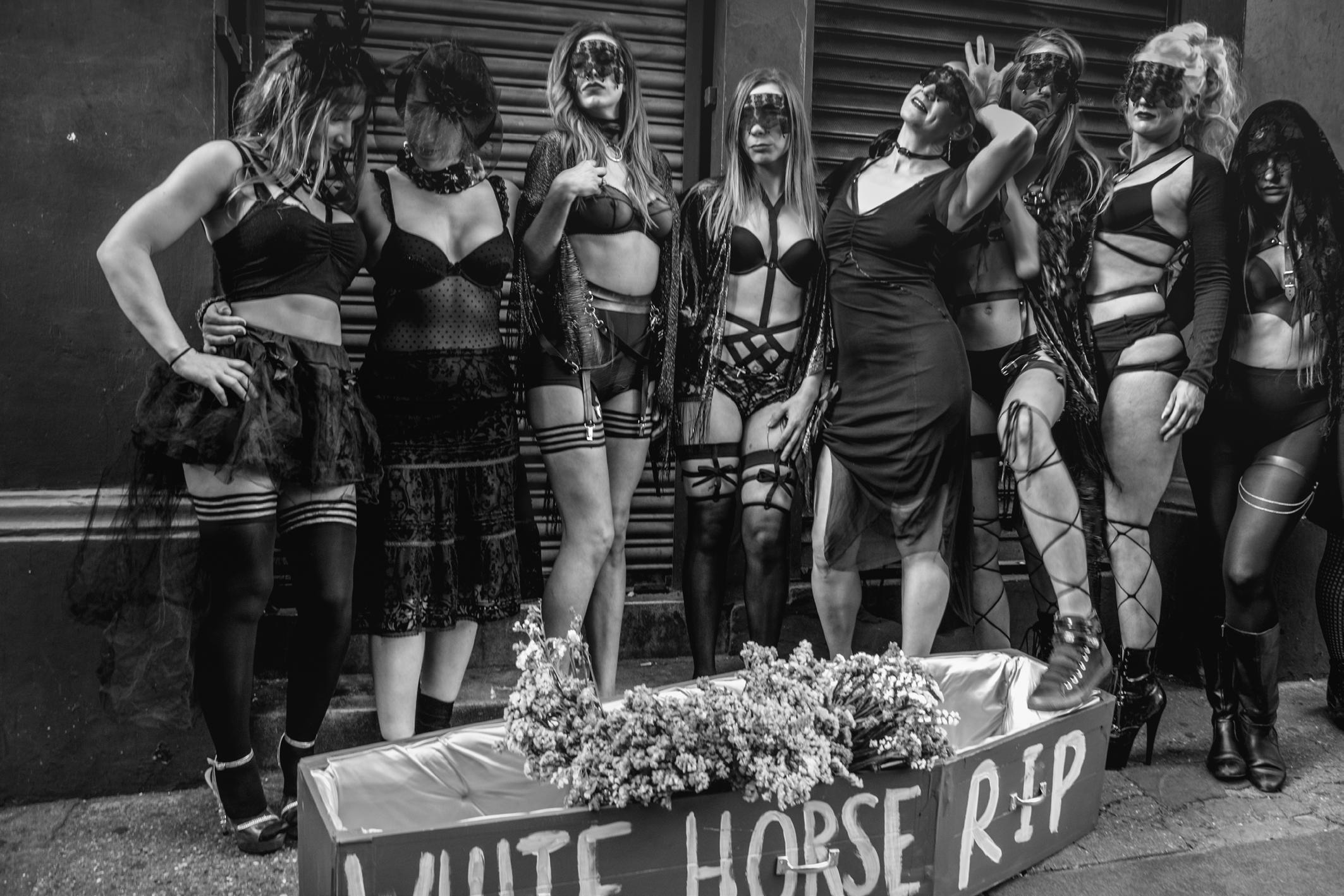
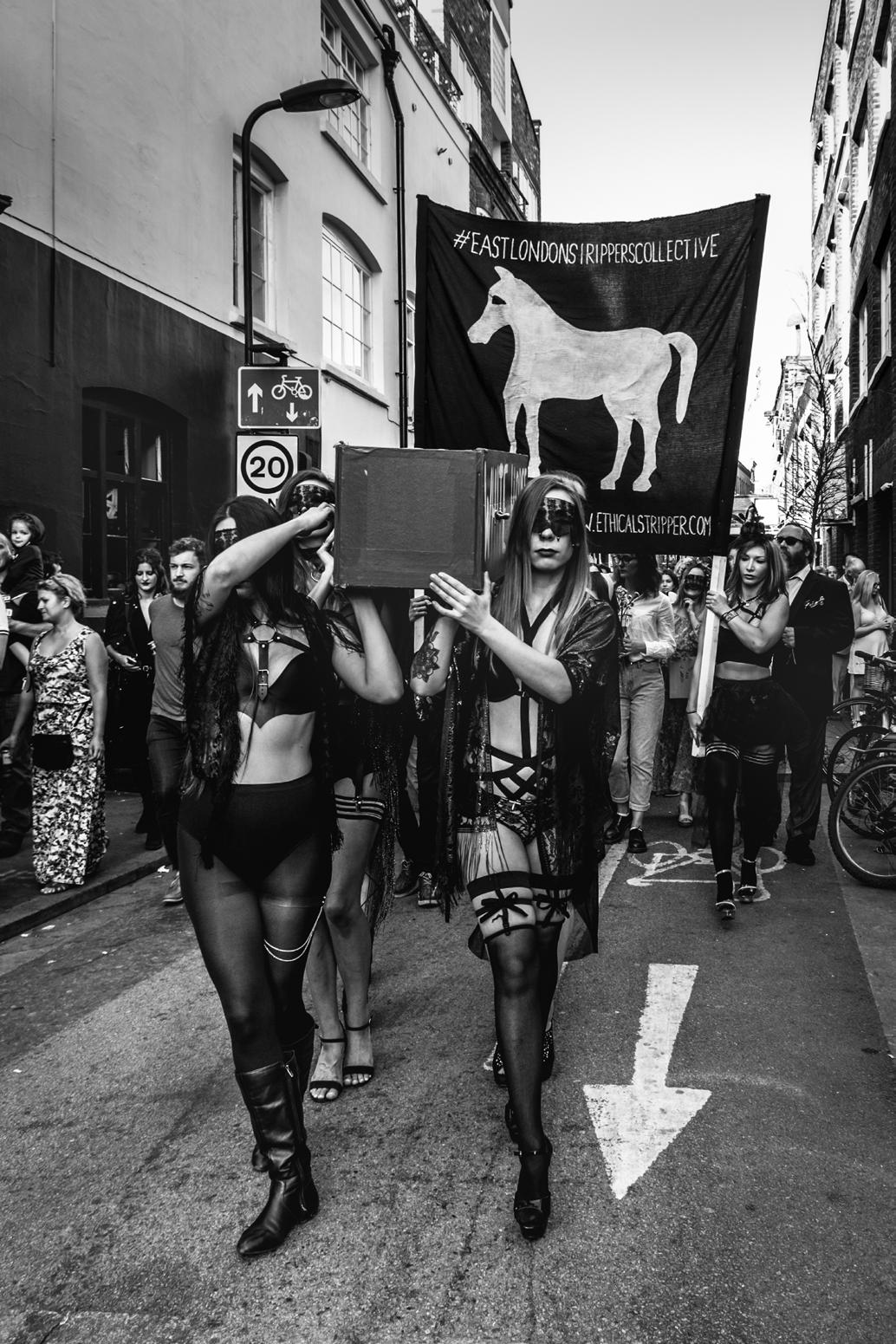


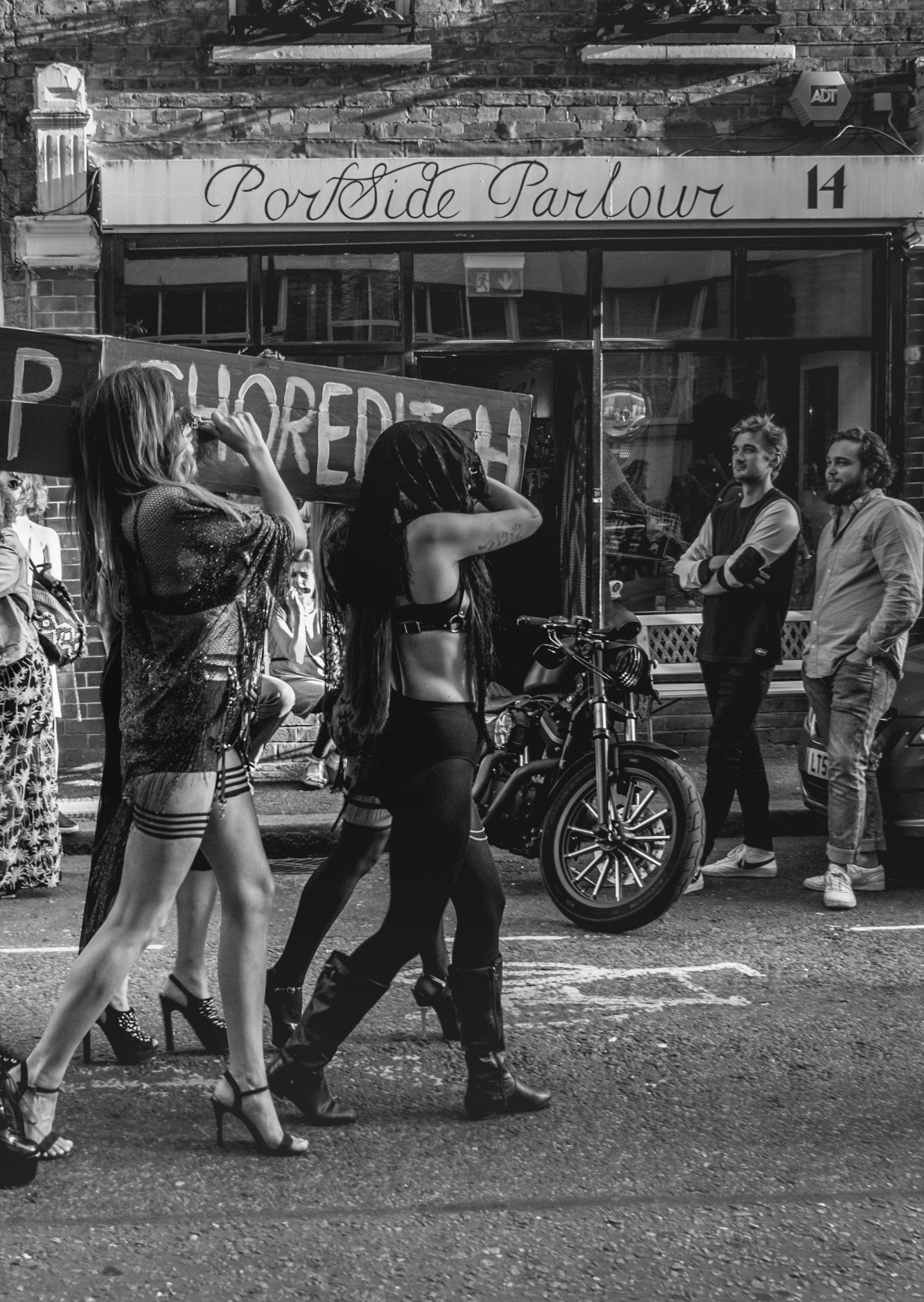


The 10th July 2015 was a landmark date, in the history of Nottinghamshire, as it brought to end 900 years of mining with the closure of Thoresby Colliery.
Coal played a vital role in the development of Great Britain, powering the country through the Industrial Revolution and two World Wars. At its zenith, over 1 million men were employed in almost 1,500 mines scattered around the country. The Nottinghamshire pits played a key role in the industry and Thoresby was the jewel in the crown. With the closure of the mine a chapter was closed in the industrial history of this country. It also brought to an end an amazing 12-month project of documenting the pit in its final days.
So as a Travel and Landscape Photographer, how did I make the leap to Social Documentary? Well it was a chance conversation with a miner after giving a travel lecture. I was asked if I would like to take some photographs at Thoresby before it closed. I jumped at the chance to grab a few different pictures for my portfolio and that was the start of an incredible project that ultimately captured an important part of our history for posterity.
I chose to present the images in black and white, with a moody and gritty feel reflecting the harsh nature of the industry and hopefully with a feeling of sensitivity as well. The whole project was shot using my Fujifilm cameras and lenses, perfect due to their size and weight, which also meant they were less intimidating when shooting portraits. This project was a tremendous personal experience. It stretched me. It brought a purpose to my photography and it certainly raised my profile. I guess all photographers would say that their personal family pictures are their most important ones and I’m no different. After those, these images are the most important body of work I have created. They represent a key part of our social and industrial heritage, and something that will never be repeated.




I consider myself a documentary photographer. I am passionate about the storytelling aspect of this genre of photography and the idea that what I am photographing is living history. For me, it is also about getting to speak with the people I am photographing, learning about them, their lives, and establishing that interaction to get a better picture.
My five images tell the story of the hard work involved in being a fisherman on the Stade, Hastings. There is no harbor, and the boats are launched and hauled back onto the shingle by bulldozers. Until 1989 this was carried out manually with the help of men based onshore, still known as ‘boy ashores’. Boy ashores are mechanics, which drive the bulldozers, help mend the nets, and some sell fish from the small huts on the Stade. Each fishing boat has its own black hut containing a winch, where nets and other paraphernalia are stored.
In my pictures, you can see one of the boats resting on the shingle with the skipper watching his mates carrying part of the days catch, off to market. In two other pictures, one boy ashore skins a dogfish and another mends nets. The picture of the three fishermen with RX55 shows them stripping out the small, unwanted fish from the nets to ensure they have been thoroughly cleaned before re-use. The last picture shows the fisherman in his hut making new floats, in the company of a non-fishing friend.
Being one of the DPOTY winners will definitely spur me on to get more involved in documentary photography. I love the idea of photographing a body of work, be it large or small, and the fact that it tells a story and something I can get my teeth into.







Interview by Mo Connelly LRPS

Interview - Polly Braden
It was a great pleasure to Interview - Polly Braden, who generously shared the lessons she learned as her career in documentary photography unfolded. Polly Braden is renowned for exploring the relationship between everyday life, work, leisure and economics. Searching for small and telling gestures, her images are acutely observed portraits and broader assessments of contemporary culture. She works on long-term, self-initiated projects, as well as commissions for international publications.
Polly was the Guardian Young Photographer of the Year in 2002; won the Jerwood Photography Prize in 2003; and was awarded the Joanna Drew Bursary in 2013. With a host of books, articles and exhibitions under her belt she is one of Britain’s leading female documentary photographers.
She has written several books, and her most recent, commissioned and published by Macintyre, is Great Interactions - a photo essay on life with learning disabilities and autism. This theme continues in her current project, Multistory, which explores the relationship of people with learning difficulties and autism with the justice system.
MC: How did your interest in photography begin?
PB: I lived in East London and used to go into Cameraworks when I was a student at the University there. I learnt both about photography and, importantly, how to print. At the end of my time there, I went to China to teach English for a year and took with me a mini darkroom, complete with enlarger. Using black plastic, I turned my kitchen into a darkroom.
As I was teaching only in the mornings, I had a year going out and shooting every afternoon. There were no other foreigners in the town, so I would go out on my bicycle into the markets and take pictures, come back, ruin lots of film as light would seep in because my dark room wasn’t dark enough. Then I would print the images. I was learning as I went.
From there I decided I want to be a photographer. When I came back I got a job as an assistant to a photographer for two years, then worked in a colour lab printing for two years. To round of my training, I did a post graduate course at the London School of Communication.
MC: This all came from within you rather than someone who fostered your interest?
PB: Yes, I think it was really the time in China – I was on my own and had to do something with my afternoons. I love photography, you can do it on your own, be in your dark room, listen to the BBC World Service and just print.
MC: Which photographers do you admire?
PB: So many, Susan Meiselas, Walker Evans is a big influence in our family, Saul Leiter. Too many to name.
MC: As a photographer, you seem to have concentrated on photographic essays, what makes these so interesting for you?
PB: To carve out the time to get to know someone is hard, but it creates a different type of dialogue. It’s only by doing longer bodies of work can you get to know someone or a subject like that rather than just diving in. For example, I’ve been photographing a 15-year-old called Rodney for my new project. The first time I met him I got to know him a bit, but the second time I met him, I realised I hadn’t got to know him at all. The third time we met I realised that he has this amazing sense of humour, we were both more relaxed and so it became a relationship.
MC: There’s a big difference between your work on the Athabasca Sands and, for example, Great Interactions. is this your work evolving, do you have a need for variety or is it something else?
PB: The Athabasca Sands was a newspaper commission, working with the writer Sally Williams. When you’re shooting for a newspaper you have a very limited budget and you must get the job done, so it’s a different kind of story.
It was already researched, but most of the photos were taken within a five-minute period. We were in a place above the Sands, but it takes a lot of effort to get there. We were working with an organisation here in the UK, who were working with a First Nations group next to the Athabasca Sands. Although there was a lot of preparation, I just had to shoot when we had the opportunity to go up in the plane. I had a massive problem in that the plane window was brown and as soon as I got in the plane I knew it was going to be very difficult. But this was the only opportunity and even if you’re involved in a long project it sometimes comes down to that five minutes. I thought the aerial shots looked good and it worked for that story.
I did a whole other part, in the First Nations town where we stayed for a week, which the Telegraph chose not to publish.
MC: Apart from China you’ve done quite a lot of work abroad – was this because you were there or was it planned?
PB: Before I had the kids, I did a lot of work in Israel, Gaza and the West Bank, and became interested in the area through meeting people there. One project, which became a book, was with an architect who worked with both Israelis and Palestinians. For another, I did a walk from Ramallah to Bethlehem photographing different aspects of the area, and then I went to Gaza. Gaza draws you back, and I went several times. Then I had the kids and I decided to stay closer to home.
MC: What is the difference between magazine feature photography and observational photography?
PB: For magazines there is time pressure, even if it’s a six-page spread in the UK you’ll still have only one day and there’s no going back. Really that kind of work has dried up. It’s hard to say why; we used to pitch a lot of stories that got made, but now it’s rare. For the type of projects that I do, such as Great Interactions, there is the time to research, plan and importantly to get to know the people you’re working with.
MC: You’ve published a lot in book form. Do you select the images and have control over the way the book is designed?
PB: Yes, for all three of the books I’ve done my own layouts. For Great Interactions, with Macintyre, I worked closely with Duncan White who is a brilliant designer. I’d sequence, and sometimes I’d want to put several pictures in a row, and we’d work out how do this. We worked closely.
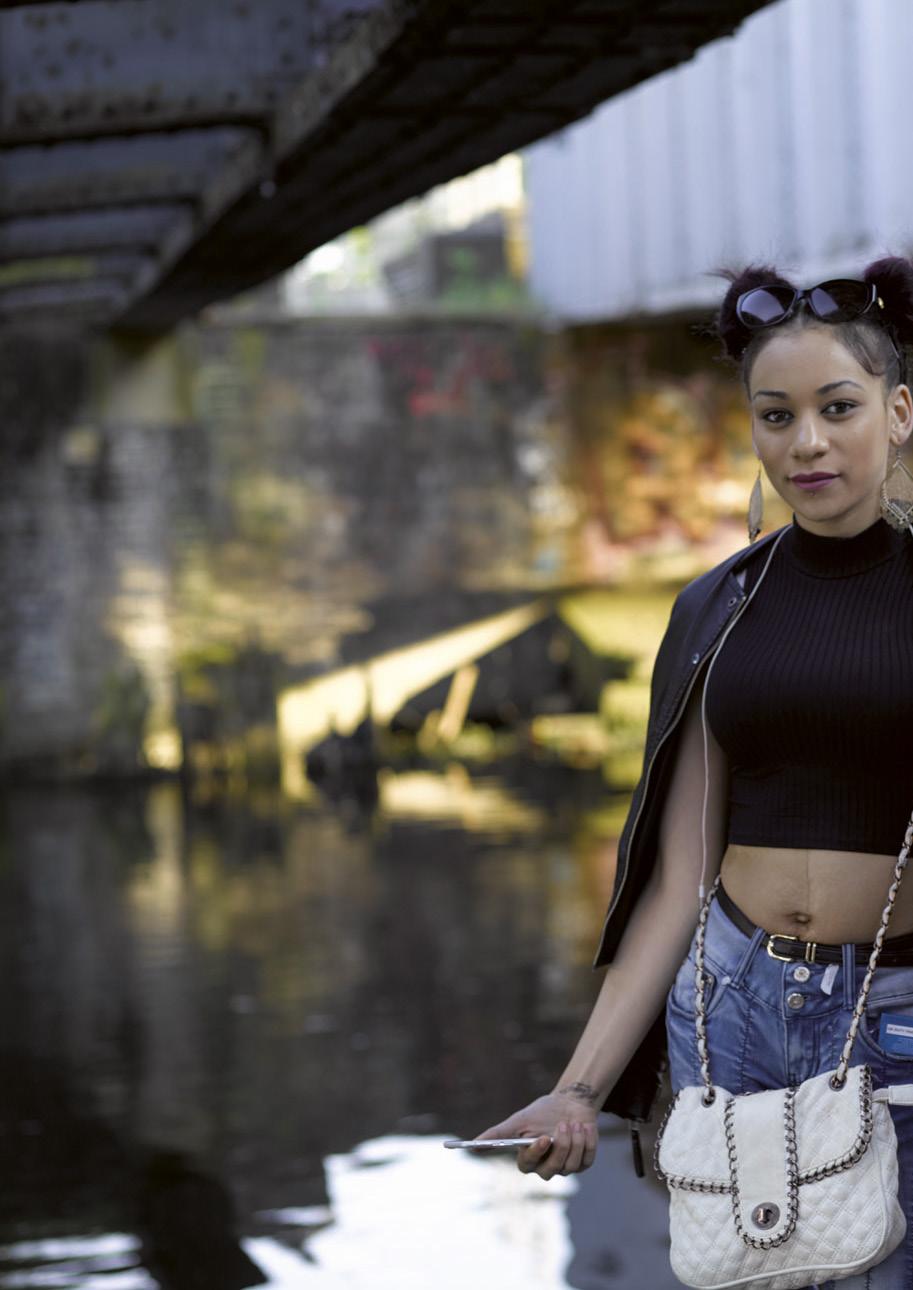

“I
MC: You often work with others on the text how does that work out?
PB: For this new project with Multistory, Sally Williams is the writer and I’ve worked with her a lot on magazines. I researched for a year with two people from Multistory and we sourced the stories. It took a lot of time to find the right ones, and now I go with Sally while she does the interviewing. Although I’m there, she will have to sit down and write the stories. That’s a solo operation.
MC: So, you’re happy with collaboration?
PB: Very happy. I love to have that bouncing and sharing of ideas. I don’t see how you can do massive projects without it. Having said that I’ve been shooting the City [London’s Square Mile] on my own for the last 12 years; at some point there’ll be collaboration with a writer, who will prepare the text, and a designer, to work on the book itself.
MC: You collaborated photographically with your husband, David Campany, on Adventures in the Lea Valley. How did that work?
PB: Yes, we shot that together, with one camera between us, and we never say who took which picture in the book.
MC: How do you prepare for a project after you’ve had an idea?
PB: I like to have some projects that I can just go out and shoot. For example, I can go out any of the day of the week on my bike and shoot in the Lea Valley. This happens. I don’t need to research anything, it’s there. I love having those ongoing spaces so that whenever there’s a spare day I can just go.
Then I like to have other projects which need very deep research, where I can get involved with writers, find an organisation to work with, and build a group of people who are interested in the project - to keep myself motivated and to make sure that it’s relevant. These projects are trying to say something that’s relevant to society today.
MC: So, you have ideas and find other people and sometimes other people have ideas and come to you?
PB: These days most of the ideas are mine and I go out to others and gather people together, even though Macintyre (Great Interactions) and Multistory both came to me.
MC: Have you found you’ve become more interested in the people side of photography since the economy went downhill?
PB: Yes, there’s so much to do. It’s endless. Society is so unequal and there’s so much to say about that. I’m always interested in stories about people and groups of people.
MC: Do you ever stage photographs?
PB: Yes. There’s a time and a place for it. I spend a lot of time watching, observing people. Recreating what you’ve seen without your camera, becomes an act anyway. If I’m with someone I’m photographing, and I don’t have my camera he’ll be completely natural and I can watch his movements. But, as soon as I bring my camera up he’ll pose, so then I need to restage. It’s still acting, but something more natural.
There are two parts of staging. If you’re staging for a newspaper and, for example, you move people around to make it look as if there are more people than there, then that’s a problem. For me, that’s really clear. In film they stage all the time. So if I’m trying to tell a story and, for example, some boys are making a cake and I arrive too late to photograph them, I’ll get them to make the cake again.
I think people get too stuck with this, it’s not an issue. There’s a difference between newspaper news photographs, which need to be left alone, and creating a story through photographs.
MC: Is there a single most memorable image you have?
PB: I really love a photo I took in a factory in what is called the richest village in China. It’s in a factory that made cloth for Burberry. It was very noisy, with old green machinery. This lady was standing in front of one of the machines, she’s wearing red and I love it.
...Then I like to have other projects which need very deep research”.
- Polly Braden


MC: When did you start to teach photography?
PB: I love teaching; it makes you think and gives you the space to go and look at work, to listen, and to read.
I have taught through the years. Now I teach one term a year at the Architectural Association, once a week. We look at the built environment, photography, and society; and I have to read a lot to prepare for it. I’m not teaching photographers but architects. I’m more interested in the stories around photography rather than teaching people how to take a photograph. Which is why I enjoy teaching people who are studying other things because they can bring those to photography.
MC: How are you doing with your long-term Square Mile project?
PB: I’m nearly at the end of 12 years of photographing in the Square Mile and recently I’ve been shooting a lot more because we’re going through Brexit. I’ve just put together a 75-page book to take the project to a conclusion.
MC: How did your current project with Multistory come about and what is it?
PB: I saw that Multistory were doing great work and I went to meet them about three years ago. Their whole remit is to document the lives of local people. I had just finished Great Interactions, which is about how much people with learning difficulties can achieve with the right support. And I was concerned about what happened to vulnerable young people who don’t get the right support. Youngsters who, as they grow and come into puberty, can become quite volatile.
The current project is about young people with learning disabilities and autism who’ve been through the criminal justice system. We’re looking, specifically, at the issues they face when going from arrest to court to prison by telling eight stories – the stories of eight people, both men and women, based around West Bromwich and Bristol because there are good organisations working on this issue there. Some are now in state hospitals, and some are now in a good place. One man keeps going back to prison since we’ve been interviewing him. We’re working with journalists and Multistory, telling the stories in depth and they’re quite compelling.
All we really hear about the problems of this group are bad newspaper headlines with no explanations. With cuts to social services, there is less chance of help as support networks are stripped away, and families face an uphill battle to look after them. These youngsters are troublesome but then get into so much more trouble because of the lack of support. So, together with Multistory, I started researching numbers in prisons. I was horrified to discover that 30 percent of people in prison have a learning disability or autism.
This isn’t something that is widely known, although there are organisations that have been working on it. For example, the

“Society is so unequal and there’s so much to say about that”.

Prison Reform Trust reported on this ten years ago, but little has changed since. We wanted to concentrate just on this group, not those with mental health problems, as the issues they face are very particular.
It’s taken a lot of research, we cast the net wide. We finally selected eight people to focus on. It’s been great to have the backing of Multistory throughout this whole project, I couldn’t have done it without them.
MC: How do you balance a peripatetic photography career with bringing up a family?
PB: It’s a big juggle and, sometimes, it is better than others. David is flexible and he often writes at home. Sometimes it gets a bit tricky, they’re now aged 8 and 10. I used to travel [abroad] a lot, but I stopped that to be around for the kids, so now I try and do UK projects, which I like as there’s so much to do here. I’m around and I’m flexible, I pick them up or David does if I’m not there – plus we have some help at home, and that’s how we balance it. Before they were school age I’d take them with me. For example, I decided to go back to China for six weeks and took both the kids with me (with someone to help).
MC: How do you manage to make a living from photography?
PB: Lots of assignments that I haven’t designed myself. Teaching. I also do some stuff for newspapers. I’ve done the book for Macintyre, plus Multistory, and commissions when they come in. All sorts really, but recently longer projects.
MC: Do you take on things you’d rather not take on?
PB: Most of the projects I take on are interesting. I haven’t taken on anything recently that I didn’t want to do. I was stopped recently by a man who asked me if I’d do some corporate portraits, but I told him I didn’t think I was the right person for it.
MC: How difficult was it for you to get your first book published?
PB: I sent my first book dummy ‘Made in China’ to Dewi Lewis as part of a competition. It took a long time to put the dummy together and whilst it didn’t win the prize he offered to publish it. For the China book, I had an Arts Council grant and I raised the rest of the money. That’s the only book I raised money for. Since then they’ve been paid for by the commissioning group. I’ve been very lucky.
MC: What are the highlights of your career to date?
PB: Meeting people, getting to know people. I think the whole experience of getting to know people with learning difficulties. I’ve met people who have taught me so much, about friendship, and who just take today as the day that’s important. That is my highlight to now.
MC: What advice would you give to a photographer starting out today?
PB: Research – I realise now how important research is. Getting to know a subject in depth and even though you don’t have to write about it, research gives a depth to my work. Collaboration and teamwork are joys - getting to know writers and journalists. Get to know the people you’re photographing.
Acknowledge the need to seek out advice. When you have a project, there are lots of people out there who know the subject, and the issues, much better than you. So, ask the people you admire, never feel shy about not knowing something.
You can see Polly’s work on her website: pollybraden.com.


“Acknowledge the need to seek out advice”.

There were over 30 entries for the third bi-monthly competition. It’s wonderful to see the diverse array of work from across the group, so please keep entering your images.
Congratulations to Stephen L Marsh for his winning image ‘Ann Summers Soho London’ and his prize, the book “The Documentary Impulse” by Stuart Franklin HonFRPS, has been sent to him.

The 2018 competition will be announced shortly, please keep an eye out for details on the group RPS page and we’ll also email you all with the details.
Please send your submissions to dgcompetitions@rps.org and visit the competition page on the RPS website for details.
On a recent visit to family in Ontario, Canada, I was unexpectedly invited to the Olympia Sports Camp, near Bracebridge.
As a documentary photographer, and not a sports ‘nut’, it gave me the chance to try capturing the spirit of the Camp, staff and students. My last visit to a Sports Camp had been in August 2016 when a group from my Camera Club took a trip to the now derelict, St Athan Boys’ Village in South Wales.
As I collected images at Olympia, I thought about the contrast between the two places and the idea to produce this essay emerged.
St Athan Boys’ Village opened in 1925 as a sports-based holiday camp for the sons of miners from the South Wales Coalfields. Activities include swimming, basketball, football, cricket and rugby. It closed in 1990, when the coal industry was in decline, and cheap package holidays to the Costas of Spain became increasingly popular.
Olympia Sports Camp opened in 1974, as the brainchild of Dave Grace and Richard Hawkins, who purchased a redundant Norwegian Airforce R&R base in remote upstate Ontario. Since then, over 100000, eight to eighteen-year-old boys and girls have passed through the Camp. Each week, from June to September, five hundred of them take part in a wide range of sports. Accommodation is in log cabins, in small groups, led by a young adult counsellor. Places are highly valued, and it is booked up quickly. The Camp motto is: “ Be the Hero of your own Story.”
My images compare the two sites: one devoid of positive attitudes to life and the environment, the other positive, proactive and investing in young people.
I was prompted to ask a simple question, yet one with a complex answer: “Why did one fail and the other succeed?” Finances ultimately caused the demise of St Athan but are there deeper social reasons? What does the comparison show about both nation’s attitudes to physical activity?









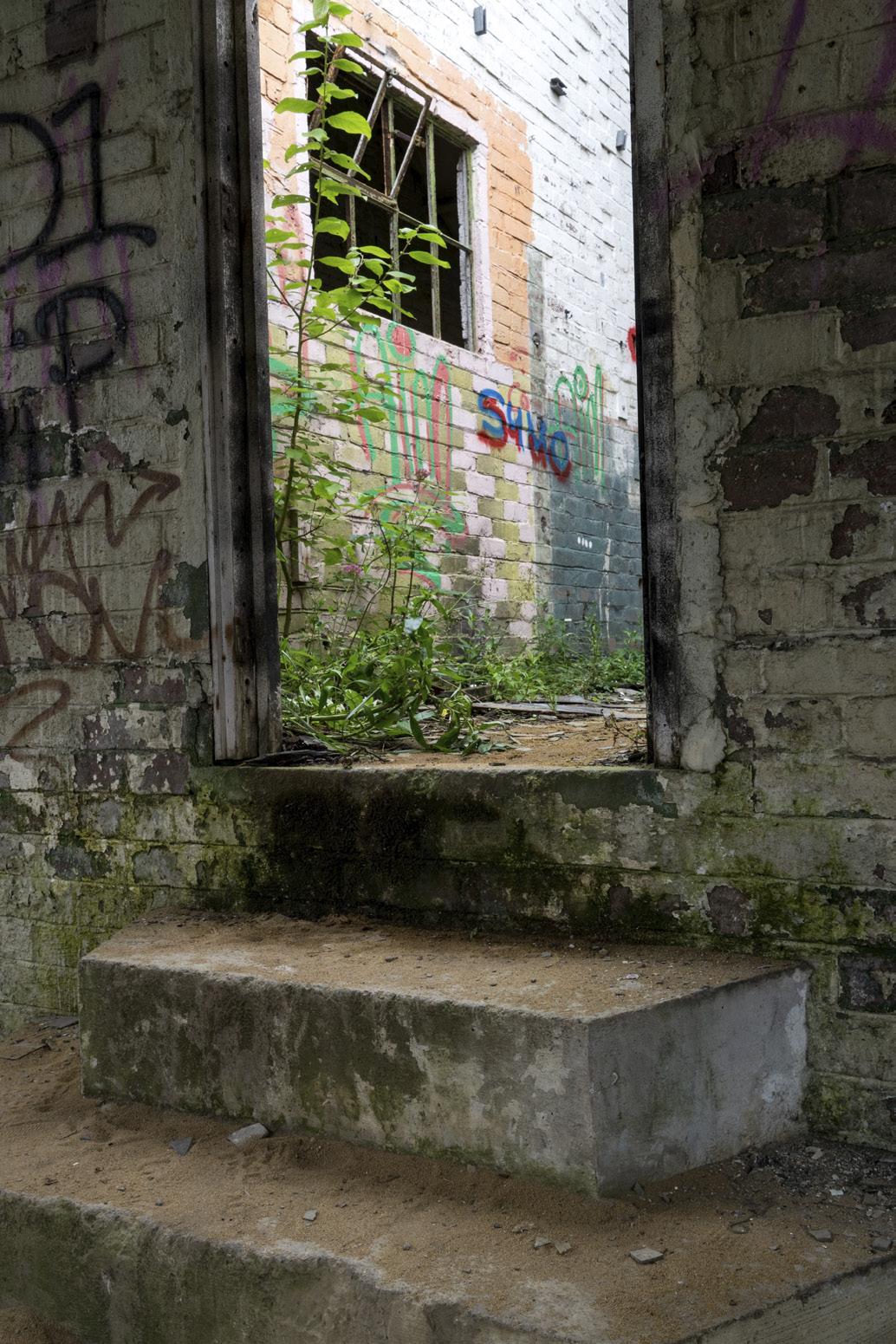




These images are all of M6 service stations, and the project records the stations as they are today. It continues to add new approaches capturing the changes in taking a break from the motorway network, and the experiences of those who use them.
Motorway service stations were once dispiriting places with basic welfare facilities for travellers and canteen style eateries. The more recently established stations now offer much better facilities and more pleasant environments for essential breaks from travelling, while most of the original stations have undergone makeovers.
Traditional service station operators Moto, Road Chef, and Welcome Break are now joined by farmshop themed alternatives, such as Westmorland and Gloucester Services. Big names from the High Street such as WHSmith provide travelling essentials and reading material, while fast-food outlets, like McDonalds, Wimpy, and Subway, provide fast food. Meanwhile, upmarket names, for example Waitrose and M&S, offer mini supermarkets as an alternative to the, more usual, take-away.
The mix is enhanced with the now essential mobile phone accessory shops and mail order catalogue clothing, while Costa and Starbucks provide coffee in comfortable lounges.
One constant at Service Stations is that fuel prices remain extortionate despite local supermarket petrol stations, often at the next junction, offer a keener alternative.
Charging points for hybrid and electric cars are becoming common, albeit in small numbers, and the transition to pollution-free vehicles will no doubt drive future changes to service stations.




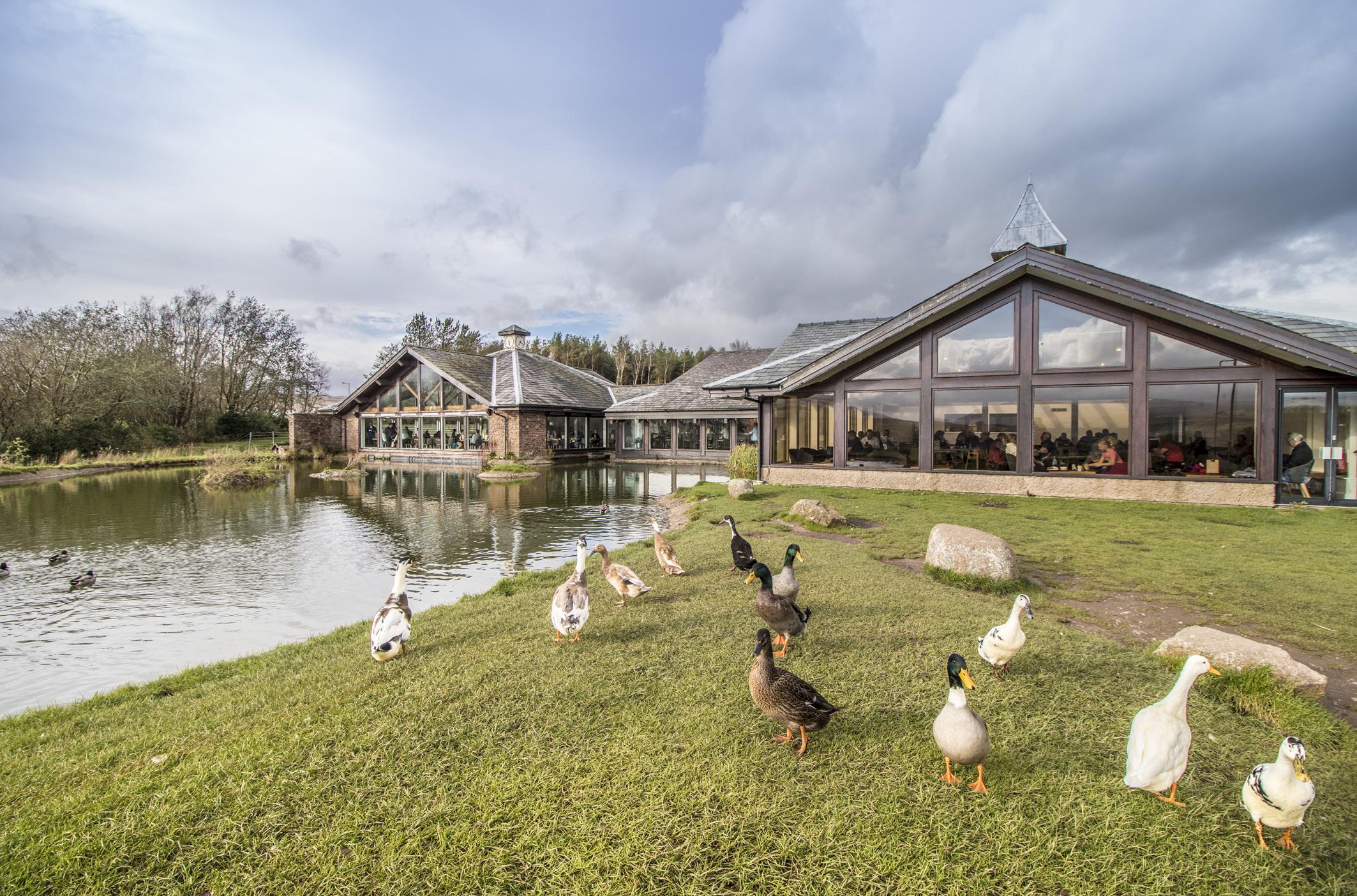



When my mother had an accident, I returned to the hometown, a small village North of Naples, in the Campania Region of Southern Italy, from which I had escaped when I was young.
The decline of this part of the country is so bad, and living conditions have deteriorated so far, that religion represents the only way to bear the burden. Aware that the situation won’t improve, people are waiting for a miracle. Religious icons are everywhere, in the streets, in the houses, and at the hospital. There too, the conditions are such that everything is entrusted to miracles and not to doctors.
I see my mother’s condition worsening, but I can’t get any information about her situation. Every day, doctors who are annoyed by me, keep repeating that; “She’s fine.” I wait for her recovery, but instead I watch her losing her mental faculties a little more every day until she enters a coma. “We cannot escape Our Lord’s will but sometimes miracles happen” is the phrase frequently repeated by the doctors as part of our surreal dialogues about her state.
Lacking any credible information, my waiting soon comes to a standstill. Suspended throughout the long hours spent in the hospital and in my mother’s empty flat, waiting becomes my life-style. I have no expectations, and I fear that she will remain in a coma for the rest of her life, for in Italy euthanasia is prohibited,
My images record moments with her for over a year. The show her temporary recovery, the hospital, religious icons spreading everywhere, her empty flat, her coma, and, finally, her death.
By documenting my mother’s passing, I used my photography to explore the meaning of life, to reflect on the role of religion, and to fix moments of my relationship with her. At the same time, photography worked as a therapy, helping me to abstract myself from the situation, thinking of my mother as a photographic subject, or looking at ways of building the story through images, and having the camera ready for the final moment.
Unfortunately, my document is also a story of the bad practices in Campania Region’s public hospitals which, even now, feature in the news daily. In Italy, Campania Region has the highest mortality rate because of the bad practices of the public health care system (91.32 x 100.000, against a national average rate of 72.93), followed by Sicily and Calabria Regions. Not surprisingly, these Regions are those strongly associated with mafia organizations.







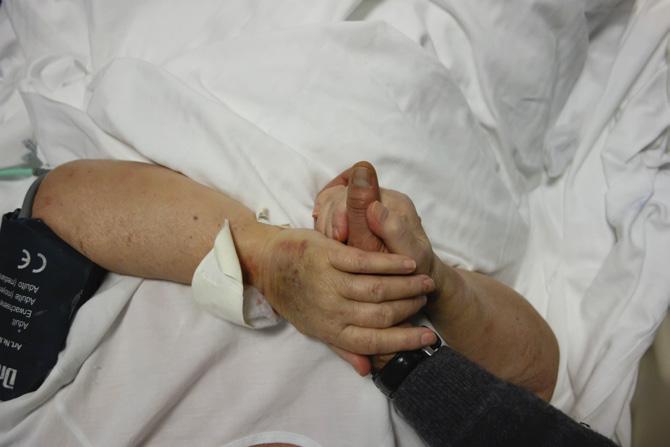
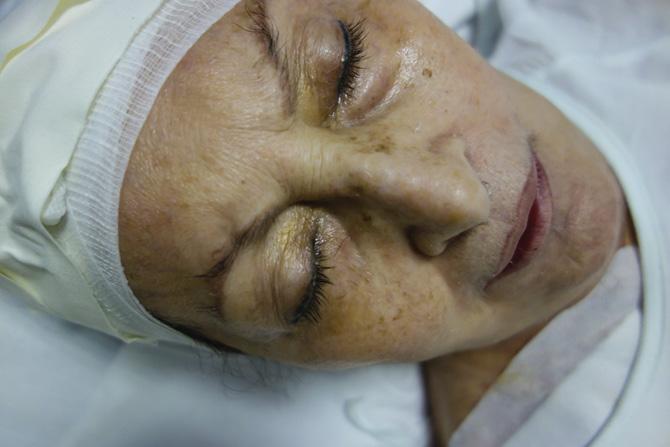




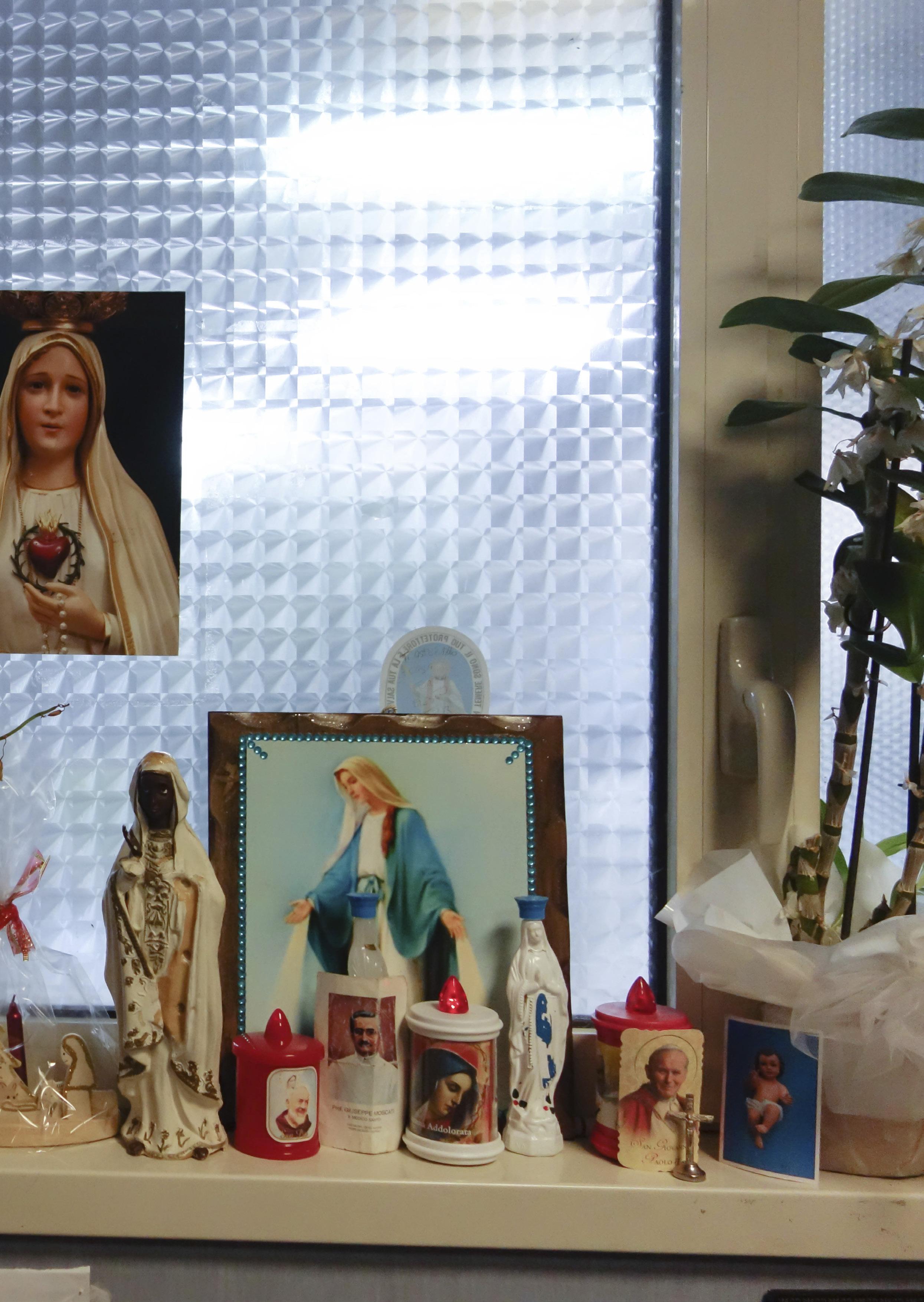






I’m a Spanish self-taught photographer based in the UK with a passion for documentary photography and a hunger for new experiences. Photography connects me with people; who they are, what they do, their experiences, moments and stories. Having finished a long and stressful project at work earlier this year, I decided to take some time out and travel for a month. It was a spontaneous decision with little time to prepare or research. I only knew I wanted to reconnect with the world doing what I love the most, photography.
Kolkata, a city I visited briefly a few years back, but didn’t get a chance to see properly, and it appealed on many levels. Initially, I found Kolkata a difficult place to photograph. Activities I had been brought up to treat as private, or considered as intimate moments, in Kolkata people would share in public. This was uncomfortable for me on a personal level to photograph. Was I intruding or crossing boundaries? Did people want to share those moments with me? The line between private and public are blurred in daily life in this vast overpopulated city. During my first experience of the mud wrestlers’ ring and my visit to the world famous flower market in Mullick ghat, I didn’t spend much time there, as I was put off by the many foreigners, like myself, with their cameras ready to take photos of this popular tourist spot many of them disregarding any sense of privacy for the people living there. It was only during my last few days in the city that I decided to return to the flower market and find out more about the wrestlers. I really enjoyed photographing them, they were extremely generous, young and old, they all welcomed me and we had a laugh together. I felt honored to be invited to join them for a fight and a swim in the river, but my western decorum stopped me. This is something I deeply regret now it would have been great fun!
Akhada is a photo book project and collection of photos I took during the course of two days whilst visiting the Akhada, the wrestling arena at the Mullick ghat, in the river bench of the Hugli River. Kusti or mud wrestling is the ancient art form of fighting with bare hands. It is an ancient tradition that is becoming a rarity these days. What was once a sport practiced by royalty among many others, is now only practiced by very few, with only three venues currently open in Kolkata. It’s a practice that dates back to 500 B.C. In ancient times it was called “Mallayudha” the art of fighting with bare hands. I’m in the process of editing the book. The book evokes the very essence of the mud wrestling; the colors and textures of spice and mud, the raw physical feel of this contact sport, putty, red-browns, and spices which capture the strength of connection between the men wrestling. The book’s look and feel aims to evoke all this, from the font cover to the layout, and the cloth and other materials I use to make it. I am also working with a professional printer based in Kolkata to print the book there and I’ll be binding each individual book by hand in Oxford.


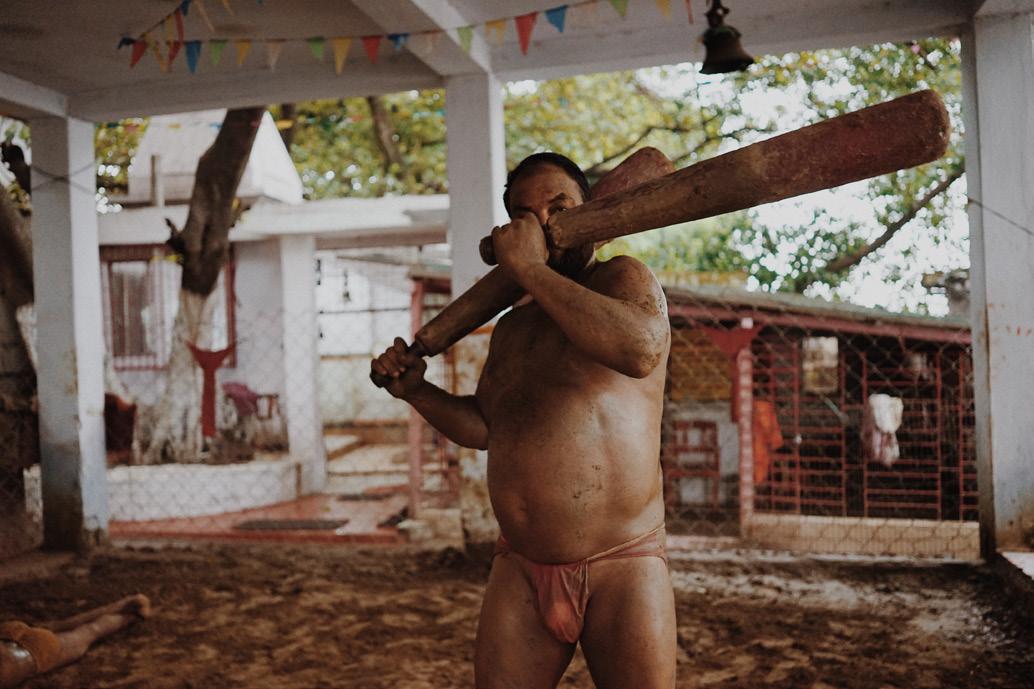



Detail of the training centre


St George’s Hub is a registered charity based in Wolverhampton where I have been volunteering for the past few years. Its aim is to help some of the more disadvantaged members of the community in Wolverhampton. Like many other towns and cities in the UK, Wolverhampton has a large group of people who, for a variety of reasons, find themselves in need of support.
We provide a range of activities and opportunities to support men, who were, are, or at risk of being homeless, socially excluded, isolated or otherwise vulnerable. The aim is to reduce loneliness and isolation and enable service users to acquire the skills and confidence to engage in the wider community, achieve stable and healthy lifestyles and (if of working age) improve their employment potential.
A breakfast club plays a pivotal role in providing a gateway to St. George’s HUB and takes place each morning. It is an invaluable resource for homeless and vulnerable men in Wolverhampton. Clients feel welcome, are able to relax and obtain a healthy start to the day so that they are able and willing to engage with St. George’s HUB staff and other agencies to address their problems. By talking about their problems with specialist staff, care plans are implemented and tracked.
With the assistance of other volunteers we deliver arts, music, sport, I.T and practical life-skill sessions. These sessions boost selfconfidence, self-esteem, reduce stress, promote self-resilience and encourage learning.
Engagement is crucial, encouraging interest from people who may feel, to all intents and purposes, invisible. We believe in a lifelong learning journey, in the very widest possible sense, discovering hitherto unrecognised talented artists, singers and writers.
Over the past few months I have been capturing daily life both inside and outside of the premises, showing that men respond particularly well if the program of meaningful activities are varied, informal and gender specific.
The experience in providing meaningful activities is that they can be a valuable first step towards further engagement. The road to freedom can often begin with a small step. In short, giving vulnerable men hope.










My first career was in primary education in London. I now work as an outdoor and nature photographer. I work with London Wildlife Trust and The Wildlife Trusts. I have documented the regeneration of Woodberry Wetlands and Walthamstow Wetlands but my favorite work is alongside The Royal Parks with their ‘Hedgehog Heroes’ and ‘Mission Invertebrates’ teams.
I’ve been working with the ‘Hedgehog Heroes’ team for a couple of years now. Ecologists from The Royal Parks education team, zoologists, park managers and zookeepers from ZSL, office workers, retired folk, professionals and non-professionals all join up with Dr Nigel Reeves and Professor John Burnell under the collective title ‘Hedgehog Heroes’. There are two surveys undertaken in the research program each year (autumn and spring) and the team monitors and tries to understand the needs of this vulnerable population in order to inform park management plans. There are only about forty animals left in The Regent’s Park and they are now additionally threatened by the high-speed rail development HS2, which plans to use the neighbouring ZSL car park as a lorry holding area. I love these long nights documenting the hedgehogs and their Hedgehog Heroes.

On survey nights, as soon as it starts to get dark we set off with thermal imaging cameras and spotlighting torches. We always hope for a clear damp night. Hedgehogs don’t like too much rain and it gets our equipment and paperwork very wet! Too dry and there won’t be enough invertebrates about for the hedgehogs so the numbers we spot and record might be artificially low. The first shift of volunteers (usually about 60, split into small teams to cover the park) finishes at about midnight. I usually work through both shifts and finish at about 05:00hrs. Walking all night through The Regent’s Park is both exhilarating and exhausting and actually quite surreal and probably none more so than the night Issy (more of Issy in a minute) was with us and ‘Jesus Christ Superstar’ which was being belted out across the Park from the Open Air Theatre as we peered into bushes in the drizzly darkness.
Finding a hedgehog never fails to turn an exhausting night into an exciting night. Once the cry of “Hog!” goes out from one of the volunteers, the group excitedly clusters around their spiky find. The hog generally obliges by rolling up into a ball but the occasional bold animal attempts to make a run for it but a nudge with a gentle foot will change its mind. Sturdy gloves are put on to handle the hedgehogs, which are then unrolled, weighed, measured and examined. Plastic markers are put onto a couple of their spines so that they can be tracked year on year. I’m quite good with animals but no matter how hard I try, I really struggle to unroll hedgehogs.
When TimeOut wanted to send a journalist (Issy) to cover the story of London’s last breeding population of hedgehogs in central London, I had a bit of extra fun capturing photos of Issy and seeing her joy when she had her first hedgehog encounter. TimeOut published 5 of my Regent’s Park hedgehog pictures with their article and at my request, made a sizeable donation to The Royal Parks/Hedgehog Heroes research fund. With a circulation of 6.5million, I have to hope that some of the readers will be more aware of the plight of these adorable little creatures. The other two pictures that TimeOut included in the article were of miniature pet African Pygmy hedgehogs #doh #epicfail. Will picture editors ever learn?
Apart from the occasional videos, which are used for training purposes, I usually take stills on these evenings. I try to document the detail of the research process (for educational purposes), the captivating beauty of the hedgehogs, the joy on the faces of the volunteers when they meet these spiky characters, and of course I try to take portraits of the hedgehogs and their heroes with a backdrop that shows that they are in the middle of London and that’s challenging! I don’t use flash photography because I don’t like the harsh shadows and steep drop off into the blacks of the night. I’ve developed a technique of using LED video lights combined with high ISOs to allow as much ambient light in as possible. I rather like the orange glow of the London sky at night.



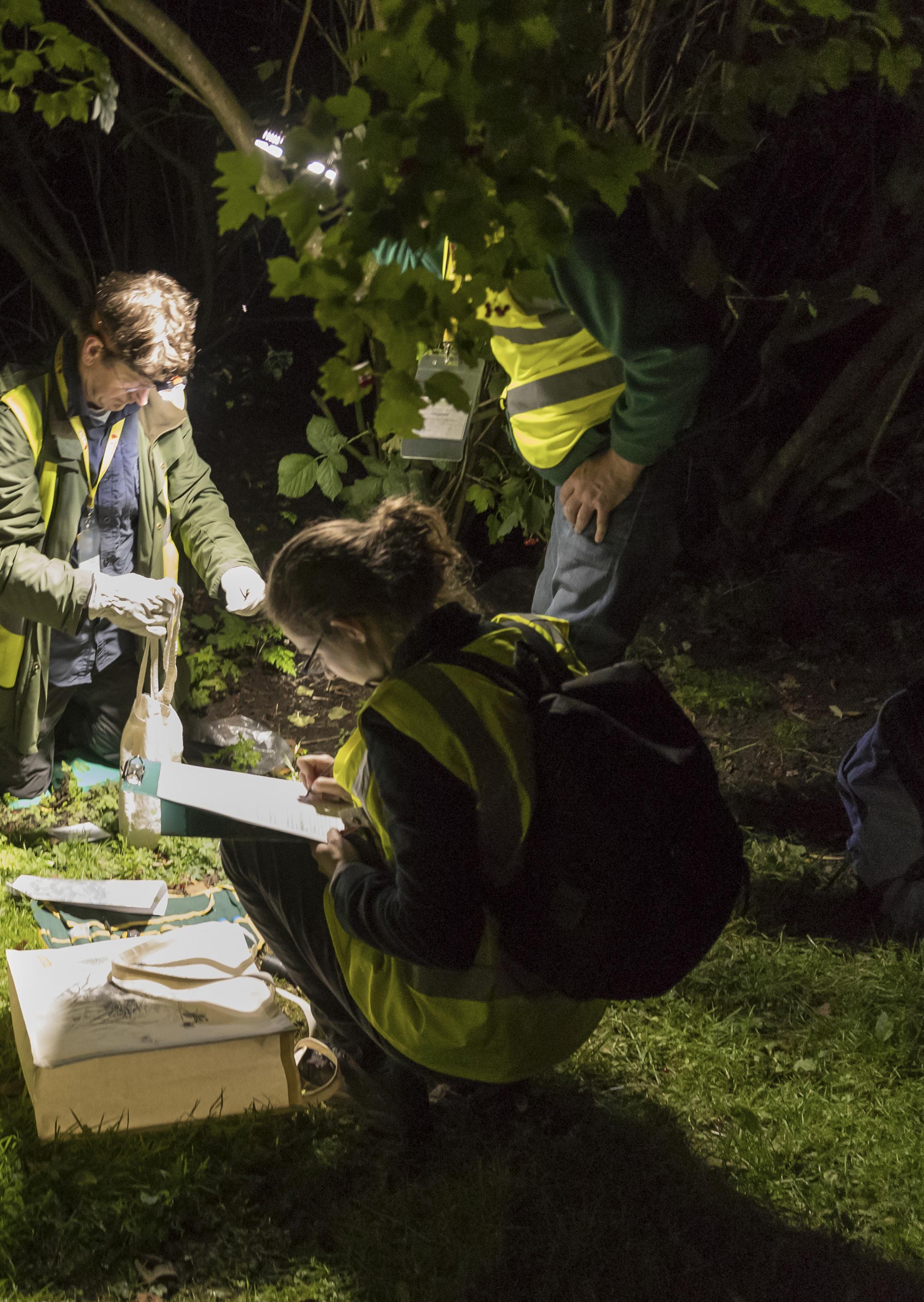
The World Press Photo Awards are a major phenomenon which began in 1955, with all nominees being taken to Amsterdam in April to receive their prizes during the World Press Photo Festival, an event which itself features photographer presentations, screenings, talks, and the Awards Ceremony. The winning images then embark on a year-long tour of 100 cities and 45 countries, which reach a global audience of 4 million people. There are eight categories; Contemporary Issues, Environment, General News, Nature, People, Sports, Spot News, and Long-Term Projects. Seven of these have two prize classes - one for a single image and one for a series of between 2 and 10 - and most have a first, second, and third place. The only difference being the Long-Term Projects category which requires between 24 and 30 images.
London’s Southbank, in the form of the Royal Festival Hall (RFH) lobby, was host to the exhibition throughout most of November. While it is very easy to get to, I am not convinced that it is the best photographic exhibition space, especially for a show of this size. The floor space was divided into two; one side concentrated on categories that were largely violent in their nature, while the other side featured the natural world and aspects of life that were not associated with war and intense human suffering. Signage was limited, and because many of the images were quite close together, it was hard to get a distance and to take in a range of images as a whole. Some were so close to the windows of the Hall, that you couldn’t get more than four or five feet away, which is not enough to look at a picture that is 3 or 4 foot long. The lighting also meant that some photos had to be looked at from strange angles to avoid bright reflections. Each image was associated with a short descriptive text - some specific to the picture, and some to the project as a whole. Consequently, the visitors embarked on a strange yo-yo activity, starting broadside on, moving in to read the text, backing off, and then hovering to and fro to find the best light. Given the close proximity of the images to one another, this dance then became a two- or three-person form of ballet. I tried to get above the show to capture a shot of this fascinating dynamic, but the floors above were closed off. So I headed to the open sided lift, but unfortunately this is quite fast, and both I and the newspaper photographer I met there who’d had the same idea didn’t manage to get anything worth reproducing here!
The better exhibitions, in my view, provide seating for visitors to reflect rather than being expected to take in a whole show in one go. Sadly, the RFH hadn’t provided this, so unless you were a caffeine addict, the best you could do was see 50 pictures, wander off for a coffee, and return to do the second 50. This was a shame, because there was plenty of scope for the RFH to have done better and to have benefited from the traffic too. And traffic there was. I visited in the second half of the month, and mid-afternoon on a weekday. I counted nearly 80 people in each half of the exhibition, and it was clearly getting busier as the afternoon wore on.
You can see all the prize winning entries at the World Press Awards website (https://www.worldpressphoto.org/collection/photo/2017). The diversity was extraordinary, though perhaps predictable; from pandas caught mid-coitus with the results a few weeks later (by Ami Vitale), to cadavers in numerous settings. The overall winner being Burhan Ozbilici whose image of Mevlüt Mert Altıntaş shouting, arm raised, after shooting Russian ambassador Andrey Karlov at an art gallery in Ankara was certainly one of the iconic press photos of 2016/7. Refugees in boats, camps, and detention centres featured a lot too.
If, like me, you go to exhibitions like this to be inspired to take better photos of your own, then this was well worth the trip. It is very unlikely that I shall ever find myself cowering in an art gallery (or anywhere else) and deciding to take photos of an assassin, but many of the projects were the kind that I might be tempted to try to tackle. Technically, the thing that most struck me was that the subjects of the majority of images were very aware of the photographer and were clearly relating to them when they were captured (well, not the pandas perhaps who seemed rather unaware of their surroundings). Thus, they were frequently taken with relatively wide angle lenses and plenty of distortion. Obviously, we all respond emotionally to different themes, and this isn’t one of my usual ones, but it was the work of two nature photographers that really caught my eye; Bence Mate’s eerie images of large wildlife in their natural habitats at night, and the haunting image by Brent Stirton of a Black Rhino slaughtered by poachers for its horn.
There’s still plenty of opportunities to visit the exhibition as it tours, though you will need to head further afield than the UK, and watch out for the new exhibition in 2018.



The Documentary Group focuses on photography which chronicles everyday life in the broadest possible way, as well as topical events and photography which preserves the present for the future, through both individual images and documentary ‘stories’. It is typically found in professional photojournalism, real life reportage, but importantly for us it is an amateur, artistic, or academic pursuit. The photographer attempts to produce truthful, objective, and usually candid photography of a particular subject, often of people.



Members form a dynamic and diverse group of photographers globally who share a common interest in documentary and street photography. We welcome photographers of all skill levels and offer members a diverse programme of workshops, photoshoots, longerterm projects, a prestigious annual Documentary Photographer of the Year (DPoTY) competition, exhibitions, and a quarterly online journal “Decisive Moment’. In addition to our AGM and members get-together we have an autumn prize-giving for the DPoTY incorporating a members social day.
Some longer-term collaborative projects are in the pipeline for the future. Additionally, we have an active Flickr group and Facebook page.
Members are offered in 2017 a single-use discount of £25 on any paid DG event.
Overseas members pay £5 per annum for Group membership rather than the £15 paid by UK based members.
The Documentary Group is always keen to expand its activities and relies on ideas and volunteer input from its members.
If you’re not a member come and join us see: http://www.rps.org/special-interest-groups/ documentary/about/dvj-membership
Find us on the RPS website at: http://www.rps.org/special-interest-groups/documentary

www.rps.org/special-interest-groups/documentary
Designed,
www.jhyturley.com
